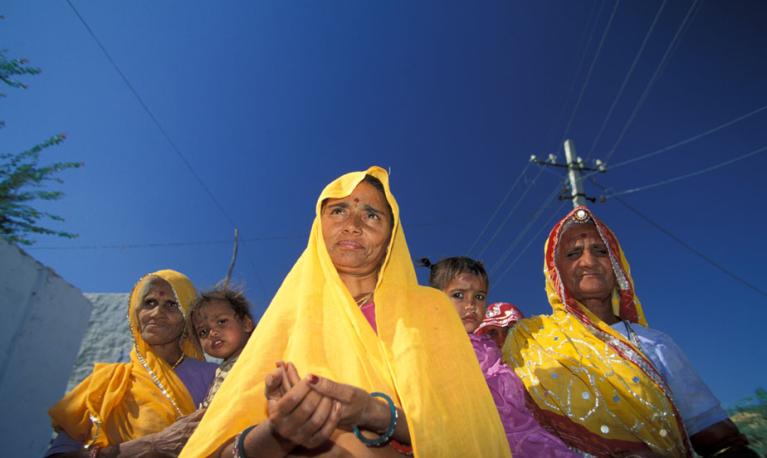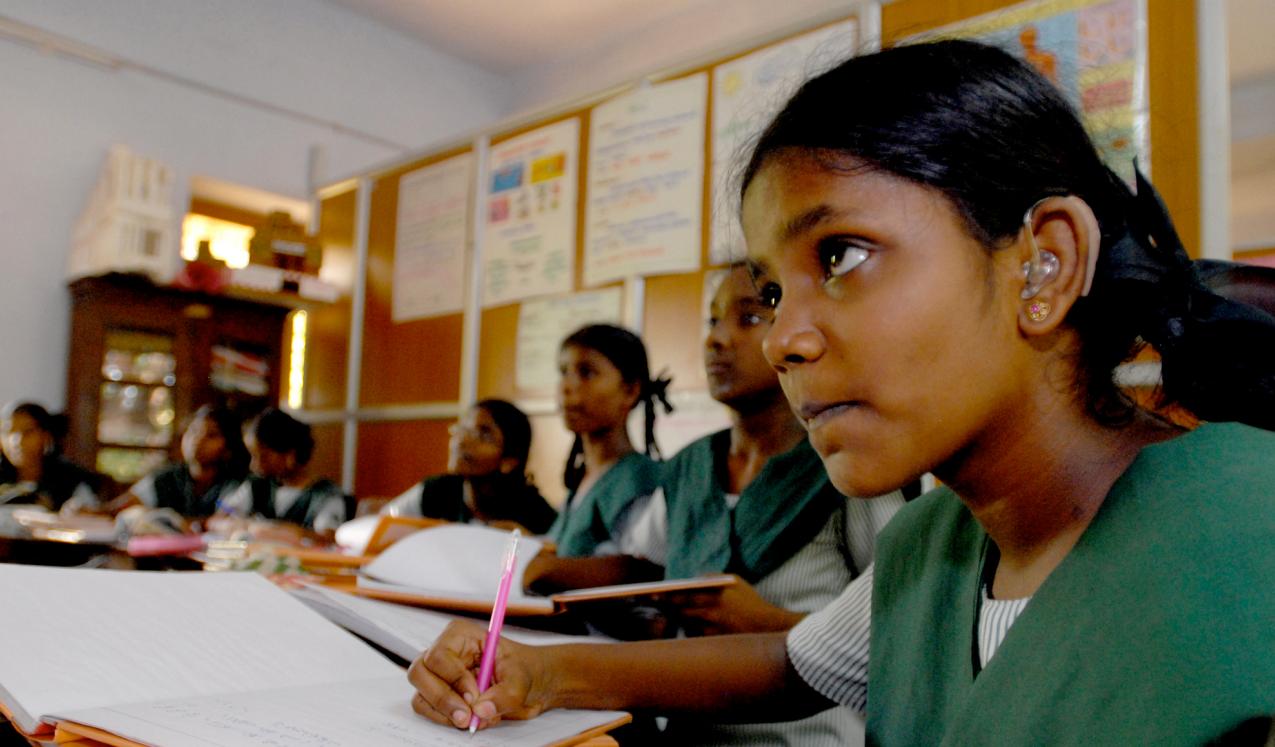
- Interview
- 3 March 2021
The expectation of perfection: interview with Nidhi Goyal on the intersection of gender and disability norms in India
- Author: Nidhi Goyal
- Published by: ALIGN
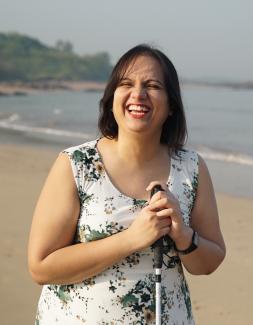

About Nidhi Goyal
Nidhi is the Founder and Executive Director of Rising Flame, an Indian NGO which campaigns for recognition, protection, and promotion of human rights of people with disabilities.
Nidhi is a disabled feminist activist from India and works on disability rights and gender justice. She is committed to changing the lives of persons with disabilities, particularly women and girls. Nidhi works to raise the profile of issues at the intersection of disability and gender through op-eds, journal articles, and lectures in national and international forums. Nidhi has been appointed to the UN Women Executive Director’s Civil Society Advisory Group, has been invited to the multistakeholder steering committee of the Generation equality Forum, sits on the advisory board of VOICE, and has been globally elected to the Board of Association for Women’s Rights in Development (AWID), where she is currently the President.
Nidhi is also India’s first female disabled stand-up comedian and uses humour to challenge prevailing notions about disability and gender.
What kinds of inequalities and discrimination do people with disabilities in India face? And how do they differ by the type of disability and by gender?
"People with disabilities face discrimination in every aspect of their lives – health, education and work – and a lack of social inclusion and exposure. If you ask people in this country, with its vast population, the majority of them have never interacted with a single person who has a disability. So this kind of lack of exposure from an early age means that people do not have friendship circles that include people with disabilities. They are not part of social networks, and are not even included when it comes to conversations on relationships, on marriage.
"The majority have never interacted with a single person who has a disability."
Of course things have changed and we are progressing. We see more and more students with disabilities on management courses and in leadership positions, but then there’s the question of which disabilities are visible? I think there’s a very able-ist lens with regards to social integration. There is a subtle discourse that focuses on what's ‘easy’ and what's ‘high functioning’. So you'll see a lot of blind individuals included in education or in corporates, and if you have a lower limb disability that doesn't really impede the work, or it doesn’t really challenge anyone’s mindset. A business might, at most, hire someone who's deaf, but then they might not have any kind of sign-language support. We don't see a lot of people with developmental disabilities, such as adults with autism, being hired.
We have very few self-advocates – people who are living with developmental disabilities, with intellectual disabilities, with psycho-social disabilities – who have been able to speak up. In fact, until the Rights of Persons with Disabilities law came out, we had a strong sense of ‘guardianship’ for people with psycho-social disabilities and others, which meant that they didn't have their own legal capacity, they couldn't be in charge of contracts, they couldn't vote, they couldn't do any of those things. It sounds harsh, but there is also a very strong hierarchy within the disability community that determines who really gets the opportunities and who receives social inclusion.
"People expect a woman to be perfect, but when there's a girl with a disability, it's a very different conversation."
Now, speaking of women with disabilities, gender norms – how women are treated – are not the same across different regions of India. In many northern parts of the country, women live under very rigid patriarchal frameworks. They are definitely the caregivers of the family (they have no choice and no voice in all of that) and they are supposed to be perfect. There's a whole language around that: the language of perfection and beauty and defect. People expect a woman to be perfect, but when there's a girl with a disability, it's a very different conversation.
That conversation and its results range from denial to outright neglect, isolating the girl and a complete lack of any investment in her. And not just investment in her education or her future, but even something as basic as buying her new clothes. She may well lack the care given to her siblings, in terms of just ordinary human behaviour towards children. In a household with a girl child and a boy child with a disability, it’s the education of the boy that is prioritised. As with most girls and boys, girls with disabilities may still have household chores, unlike boys with disabilities. And only when she has finished her chores will a girl have a chance to do her schoolwork, if at all.
"Who's going to be looking at you? And why are you going out anyway?"
Also many people with disabilities have told me ‘we're not allowed to buy new things because people – our families and neighbours – would say –‘why would you need a new dress for this festival? Who's going to be looking at you? And why are you going out anyway?’ Because a person with disabilities is treated as particularly inauspicious, there is this very strong idea you and your entire family would not be invited to celebratory moments, to marriages, to social functions. There’s also the idea that you add to the burden of your family, and why would people invite someone who is either a burden – a barrier to the enjoyment of something that is fun, or sacred?"
People think that it is the woman – and the woman alone – who is responsible for these so-called ‘imperfections’.
I have worked on a campaign on sexual and reproductive rights of women and girls with disabilities for the past decade. Society (and many individuals within it) still holds to eugenic principles, and they have this assumption that disability breeds disability. But in India’s history of forced sterilisation, this was only inflicted on women. And thankfully, there has been a heavy reduction in such practices, even over the past three or four decades. This was a conversation we were having in the 1970s and 1980s and activists for women’s rights spoke up. But today, women with disabilities in India are still in that space. And still we see that it is the women with disabilities who are sterilised, not the men. How does that improve anything? People think that it is the woman – and the woman alone – who is responsible for these so-called ‘imperfections’.
There is one sentence in the 2016 Rights of Persons with Disabilities Act, which says you cannot terminate the pregnancy of a disabled woman without her consent. But the termination clause immediately goes on to say, 'except in cases of severe disabilities, when a medical practitioner and the parent take a decision'. And there is no definition of severe disabilities anywhere. So it's very evident that the sentence was either a tokenistic provision or that lawmakers and society still want this kind of exception so that they could exercise control over the sexual and reproductive health of women with disabilities."
How do other kinds of identity interact with both disabilities and gender?
"There are so many intersections. But first of all, the fact is that disability is not always recognised as a cross-cutting issue. And I think the disability and gender movements do not always speak to each other. If we're talking about violence against Dalit women with disabilities and their access to justice, just the fact that the girl who has been raped is a Dalit girl and disabled means that she would absolutely not be believed, even if there was evidence and testimony that would seem reasonable for anyone else.
But such injustice is not an ‘additive’ it's not like a double burden of caste and disability – it's truly more complex than that. It's complex when you're trying to access services and rights, when you're trying to exercise them, when you're trying to get included socially or have equal opportunities. Now, unfortunately we don't have enough data because we don't even have specific data like the crime records around disability. So how do you even begin to find data on intersectional issues?"
Could you tell me more about examples of intersectional collaboration that spans a number of different kinds of identity?
"Ten years ago, there was silence about disabilities in the LGBTQI+ community. Now the different communities want to collaborate more. A few disability rights activists, for example, are openly queer and are an equal part of the organization, so we're moving forward. And the same is true, I would say, for the groups for women's rights and for women with disabilities. There are many, many senior actors and younger actors who share that space, who give that space, and who listen to women with disabilities.
"The onus is still on the women with disabilities to come forward."
But the onus is still on the women with disabilities to come forward and say, for example, ‘hey, this venue is not accessible.’ That kind of understanding of, OK, what does accessibility really mean? What does reasonable accommodation mean? What does universal access mean? That is still not really being built from within the different organisations and groups. There are very few actors who are trying to build their own capacities and their learning.
I'm not being cynical here. I do want to acknowledge that there is a definite movement and definite progress. If you have an inter-movement ally-ship, that really is a strength. We want to expand this supportive space for people with disabilities. We've moved forward, but there's still some way to go in terms of really building our ability and understanding."
Could you talk a bit more about how you've worked around ally-ship?
"All right, big question! I'll talk about ally-ship in specific contexts. I sit on the Generation Equality Forum, and I'm also a member of the multi-stakeholder steering committee, so working on multiple levels in my capacity, and through my organisation. There was always this understanding in my head that Beijing +25 was about all women and that means women living at multiple intersections. But, when civil society report was being developed in 2020 at the national level, there was no active inclusion of women with disabilities, and there was no deliberate sharing of information with women with disabilities, for a report that was going to feed into the Beijing +25 regional processes. So we were extremely concerned. And so we raised our collective voices at the right time, with Rising Flame holding a virtual national consultation for women with disabilities to see where they stood on the six or seven priority areas of the Beijing charter and, as a result, we came up with a report and fed it directly into the regional space. By taking such steps and showing that, OK, this Beijing +25 anniversary belongs to us as well at regional, national and local level, we were integrated equally.
"It was important for women's rights activists to work with women with disabilities."
Ally-ship always works through such negotiation and collaboration. I entered disability work through a women's rights organisation because the disability rights organisations were not open to a discourse on sexuality and disability 10 years ago. Many feminist and women’s rights organisations were, however, absolutely on board on gender, disability, sexuality, reproductive health and rights. To open up conversations on these subjects within the disability movement, I saw collaboration as a vital strategy, and it was important for women's rights activists to work with women with disabilities to bring these discourses across into the disability community. And that's the beauty of standing at intersections, because you can feel at home in different movements that are linked to different parts of your own reality."
What do you feel has played the greatest role in changing social perceptions of women with disabilities, and of people who live at multiple intersections?
"I think it's an overall social change, with more opportunities meaning more visibility, and that is what lies at the heart of social change. Now we all have access to the world as if it were a small place, maybe through Netflix, TV, news, whatever. Mindsets are changing because there's more interest. For example, someone sees a film or documentary about dyslexia and they think ‘Aha! So that is what dyslexia means!’ That is good, but the learning too often stops right there. Where we're starting to see movement is the result of the greater exposure of more people to the realities of disabilities. But unfortunately, that movement also stagnates at some points.
I think that educational opportunities really help to drive change. As we fight for, and move towards, inclusive education for children with disabilities, and as we work towards greater employment opportunities, we start to see people with disabilities as a natural, everyday part of society. And that is what really drives change."
You’re also a comedian. What is the potential of comedy to change mindsets and norms around issues such as disability and beyond?
"I think there's a lot of potential for art in itself, not just comedy, to change social perceptions in a way that nothing else can. Because art spreads, art reaches your soul and goes beyond what your own intellect or your own life experience is telling you. Art really can change the language, the perception and the narratives around disability, and that needs to happen. And art can bring visibility to issues at a far greater scale than most other approaches. Activists can talk to governments, and activists can talk to people, but art can really have an impact at another level.
"You're laughing and reflecting at the same time."
When you challenge someone on their mindsets, they might become defensive, or shut down further or even be offended. But you can do it through comedy, which is supposed to challenge everyone anyway. That’s why people don't want to sit in the front row when a comedian is performing! They know that the comedian is likely to pick on you, so by being there you are already opening yourself up to that challenge! And then you're laughing and reflecting at the same time.
That's why comedy has such great potential to really change mindsets and bring that change that we want to see. I think that a really good Bollywood film that features people with disabilities as main characters – and not just to trigger sympathy – could really do wonders. It would have a massive impact. I would love to see one of the real Bollywood fairy-tale stories of romance to have someone with disabilities as the main protagonist."
Could you share the main highlights of the Neglected and Forgotten Report?
"Let me just give you some context. This whole issue of invisibility stands out even more starkly in this conversation, given the current disaster caused by Covid-19. This is a public health emergency, and India has declared the Covid-19 situation to be a national disaster. And in any national disaster, who is forgotten first? People with disabilities, as we see in many spaces worldwide.
"We don't always realise that the digital world has an able-ist lens."
First, access itself becomes difficult: access to food and other essentials, access to health services, and so on. Those who already struggle with access face even greater challenges. And there is very little awareness, not just in India, but globally, of the barriers faced by people with disabilities in this digital world – not just for those who are blind or have visual disabilities, like me, but for those with every form of disability. We don't always realise that the digital world has an able-ist lens. That is something we highlighted in our Neglected and Forgotten report: the way in which inaccessible digital spaces hamper independent living, making it difficult for people with disabilities to order their own food, or even access one of the main Covid-19 apps created in India: Aarogya Setu. So I wanted to really highlight this issue of digital access because it's truly universal and we don't fully understand the impact of lack of access on the independent living and full participation of people with disabilities.
The report also points out the various connections between gender roles and the lack of access for women and girls with disabilities to health support and to treatment for debilitating conditions, and the impact on their emotional well-being. Those linkages come out very strongly in the report.
And second, we need to plug the growing cross-movement collaboration and ally-ship into the conversation around this current crisis. Within the global pandemic, there is another ‘shadow pandemic’ of domestic violence. But women living at the margins and in that shadow, including those with disabilities, were really not considered in the response. They were going to have even fewer escape routes and fewer complaint mechanisms that could help them, and they would go through even more severe forms of violence because they could not get that help, and could not get away. They have been forced into a situation where, because of lack of services, they have had to lean on family members and caregivers.
"Women with disabilities continue to slip between the cracks of different movements."
At the same time, the Department of Persons with Disabilities in India came up with this policy guideline on responding to people with disabilities in the lockdown, and we were really hoping that there would be some mention of women with disabilities. There was, but it was a single line. And that's when this really struck: the movements are not necessarily thinking about each other and women with disabilities continue to slip between the cracks of different movements and different identities, particularly in crisis responses.
This is highlighted in the report’s chapter on domestic violence, which notes that many women that face all kinds of violence. For example, India has a Domestic Violence Act, but does it include a threat to a girl with disabilities, that unless she finishes all the household work or unless she cooks for the family, they will withhold the essentials she needs? After all, she cannot go out and has no government support to help her get what she needs. What kind of violence and abuse is this? Which movement occupies the relevant space for her?"
Any final thoughts?
"One message I want to finish with is this: when we talk about change, and how the world can build back better, what action is needed? Rising Flame is committed to a long-term vision where people with disabilities are not only visible, they are a force for change. I’ve said this many times: we need leaders who are women with disabilities, and we need leaders who stand at multiple intersections so that they can bring their realities into policies and approaches. There also needs to be space for, and acceptance of such leaders, particularly women and youth with disabilities, as future leaders.
"Nothing about us without us."
The disability movement quite rightly says ‘nothing about us without us’, but when it comes to women with disabilities, when it comes to queer folks with disabilities, we are not applying that principle. The vision of national leadership programme, I Can Lead, the first of its kind in India, is to create the leaders and self-advocates of tomorrow, so that women with disabilities can go and change the world so that it works for them, rather than waiting for someone to come and change the world for them."
- Tags:
- Intersectionality, Disability
- Countries / Regions:
- India
Related resources
Briefing paper
2 October 2023
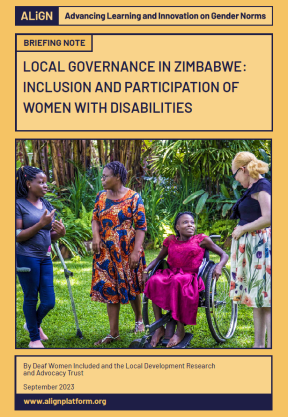
Blog
7 January 2022
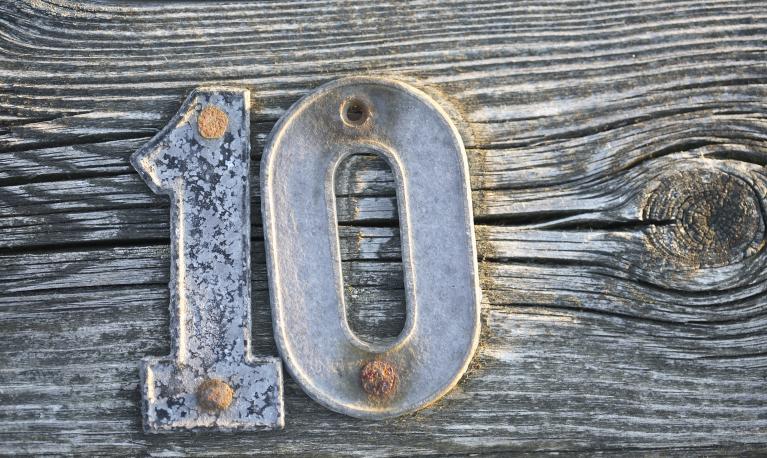
Biblio/Lit. review
22 March 2021
